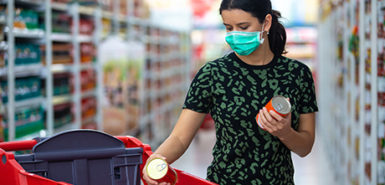
With the whirlwind of the initial COVID-19 shutdown now months behind us, most grocery stores have finally managed to re-stock their shelves—and keep them stocked.
We’ve all been relieved to find our usual grocery list usable again.
You may have noticed, however, the grocery bill is not back to normal.
As of June, the total increase in food prices for U.S. consumers is 4.5%.
If we were to break this down into food categories, the price increase for meat, poultry, fish and eggs is No. 1—at a 12.8% increase.
Beverages are second at 5.3%, while dairy ranks third at 5.1%.
Cereals and baked goods saw a 3.3% increase.
There’s no food shortage, but simple supply and demand—along with the closing of some meat processing plants, alongside job woes—has impacted food prices and our pocketbooks.
How best to handle it all?
Here are six ways to work on your tight budget, while also improving your waistline and health.
Go plant-based
Since animal products are the most expensive food—and they’ve had the greatest cost increase recently—you can focus on using plants as your base diet.
Aim for fewer animal products. Most people eat far more protein than needed.
You can easily meet protein needs with plants. Women need about 45 to 50 grams each day and men need about 55 to 60 grams.
Make simple swaps
Use lentils in place of ground beef for tacos or spaghetti. Add chickpeas or other beans in place of meat on your salad. Use peanut butter or hummus sandwiches or wraps instead of lunch meat.
Use black bean burgers or portabella mushrooms for grilling, or grill veggies with a beans-and-rice side instead of grilling meat with a veggie side.
For an extra protein boost, snack on pumpkin or sunflower seeds, steamed edamame, roasted chickpeas, veggies and hummus, or fruit and peanut butter.
And don’t forget to load up on veggies. Each cup contains 4 grams of protein.
Be sure to swap your grains, too. Use quinoa in place of rice or bean flour enriched pastas, wraps and crackers. It will increase protein and nix the need for any meats or other animal proteins.
Dump the drinks and processed snacks
Seems like a simple and obvious choice. But since these items are unnecessary and generally unhealthy—not to mention they cost more—the fewer things you buy, the more you will save.
Buy staple foods in bulk
If you have a little more money up front, buying those frequently used shelf-stable items in bulk can save a lot in the long run.
Plus, it can save you time running to the store less often, as you’ll have more items on hand.
Think items like brown rice, oats, quinoa, beans, olive oil, or whole wheat flour.
Plan ahead
Sit down weekly and plan out your meals. Start with staple foods in the house. Check out the sales and make a list when shopping. This limits waste and also keeps you on track when shopping.
Eat at home, pack work lunches
The COVID-19 pandemic has certainly forced more people to eat at home.
But having more meals at home—and having healthier options, to boot—will go a long way in protecting your budget and your body.
Planning ahead can also help in this area. You won’t be left scrambling to cobble together a meal at the last minute or, if there are not healthy ingredients around, you won’t feel compelled to pick up takeout.

 /a>
/a>
 /a>
/a>
 /a>
/a>